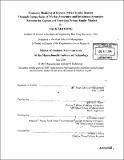| dc.contributor.advisor | Stewart C. Myers. | en_US |
| dc.contributor.author | Baek, Kiwoong, 1960- | en_US |
| dc.contributor.other | Sloan School of Management. | en_US |
| dc.coverage.spatial | a-ko--- n-us--- | en_US |
| dc.date.accessioned | 2005-06-02T18:55:43Z | |
| dc.date.available | 2005-06-02T18:55:43Z | |
| dc.date.copyright | 2004 | en_US |
| dc.date.issued | 2004 | en_US |
| dc.identifier.uri | http://hdl.handle.net/1721.1/17852 | |
| dc.description | Thesis (M.B.A.)--Massachusetts Institute of Technology, Sloan School of Management, 2004. | en_US |
| dc.description | Includes bibliographical references (leaves 198-202). | en_US |
| dc.description.abstract | Modem capitalist societies depend on entrepreneurship for their progress. Entrepreneurs seek profits by introducing new goods, services, and technologies and, in doing so, they advance the economic welfare of society. To maintain and further entrepreneurial activities, each society requires a well-organized resource allocation system that can distribute resources to selected industries or firms. The private equity market is an efficient resource allocation system that provides equity capital to the firms not quoted in the stock market. However, a private equity market is difficult to develop not only due to the high risk characteristics of the market but also because of the needs to establish value added infrastructure and to change the current financial mechanisms as the capital market evolves. The government plays one of the most important roles in initiating a new type of capital market, the private equity market. Significant changes and evolution in the development of private equity markets are typically preceded by changes in the regulatory system (deregulation), tax structure, monetary policy, government policy, and/or pension fund operations. Different starting points lead to different paths of market development. However, many countries have tried to introduce private equity markets with various degrees of success. These attempts highlight the fact that different schemes of private equity market structure are necessary for each country. They will, however, converge into one economic model with efficient and effective resource allocation system in the long run. This thesis analyzes the development history, development strategy, and current situation of the private equity industry in Korea and compares it to | en_US |
| dc.description.abstract | (cont.) the overall situation in leading global countries-specifically, United States. It ultimately delivers recommendations for government policy and investment strategies in Korea and discusses economic modeling aimed at providing guidelines on how to successfully introduce a new private equity market in a certain country to serve as a resource allocation system. Through this thesis, I found that Korea's venture capital industry made an unprecedented economic improvement on the basis its economic recovery after the Korean financial crisis and the introduction of government supporting programs and the KOSDAQ stock market. The KOSDAQ stock market created the third largest market capitalization in the world emerging stock markets. In just eight years, this emerging stock market became a leading trading center in OECD countries due to government driven policies of the previous 22 years. It stimulated the shifting of economic growth engines from large firms to small technology firms in Korea. But after the IT bubble collapsed in 2000, it also experienced long re-adjustment period. Korea's venture capital market seems to have entered into a transitional period from the more government driven system, characterized by corporate venture capital firms, to a market driven system, characterized by limited partnerships, from which the US venture capital market evolved in the 1980s. The Korean venture capital market seems to be about 20 years behind the US market in terms of its economic maturity. The current Korean market situation is similar to that of the American market in the early 1980s ... | en_US |
| dc.description.statementofresponsibility | by Baek Kiwoong. | en_US |
| dc.format.extent | 202 leaves | en_US |
| dc.format.extent | 15318797 bytes | |
| dc.format.extent | 15343923 bytes | |
| dc.format.mimetype | application/pdf | |
| dc.format.mimetype | application/pdf | |
| dc.language.iso | eng | en_US |
| dc.publisher | Massachusetts Institute of Technology | en_US |
| dc.rights | M.I.T. theses are protected by copyright. They may be viewed from this source for any purpose, but reproduction or distribution in any format is prohibited without written permission. See provided URL for inquiries about permission. | en_US |
| dc.rights.uri | http://dspace.mit.edu/handle/1721.1/7582 | |
| dc.subject | Sloan School of Management. | en_US |
| dc.title | Economic modeling of Korean private equity market through comparisons of market structures and investment strategies between the Korean and American private equity market | en_US |
| dc.type | Thesis | en_US |
| dc.description.degree | M.B.A. | en_US |
| dc.contributor.department | Sloan School of Management | |
| dc.identifier.oclc | 56606176 | en_US |
